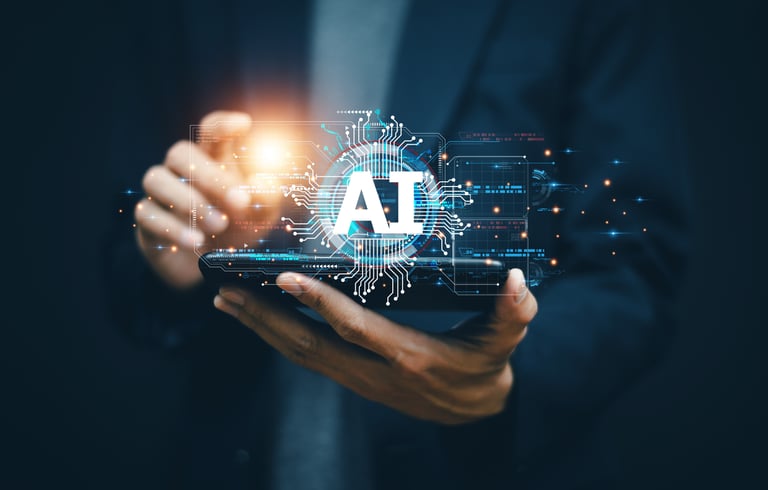Abstract
Artificial Intelligence (AI) technology has enabled Frontend developers to enhance the user interface (UI) and user experience (UX) design of web applications.
Machine learning, natural language processing, and other AI techniques are used to improve the functionality and usability of web applications.
Machine learning is an AI technology that enables web applications to learn from data and improve over time.
It is used to develop recommendation systems, personalization features, and content analysis.
Natural language processing (NLP) is another AI technology that processes human language in a way that computers can understand.
It is used to develop chatbots and voice assistants that engage users in conversations.
Other AI technologies used in front-end development include computer vision, which helps web applications interpret and understand digital images, and sentiment analysis, which analyzes the sentiment and emotion of written and spoken text.
AI in Frontend Development
Frontend development is witnessing a transformation with the integration of artificial intelligence technologies.
Artificial intelligence features are used to improve user experience and optimize development processes.
Let's take a look at some real-world examples of AI applications in frontend development that are changing the web.
- Personalization
AI allows websites to provide personalized content and product recommendations by analyzing user data and behavior.
This dynamic approach increases user engagement and overall satisfaction, providing convenience and a personalized experience for each visitor. - Stimulating Customer Engagement
Frontend developers leverage AI-powered chatbots to enhance customer engagement.
These chatbots foster real conversations, providing quick responses to user queries and guiding them through various actions on the website, effectively replacing traditional customer service specialists. - Quality Assurance
Artificial intelligence algorithms have made quality assurance and service tasks more efficient.
Developers can now use artificial intelligence to improve the speed and performance of their websites, while also gathering valuable data and insights to provide a seamless user experience. - Faster Coding
AI has revolutionized the coding process by automating various tasks and allowing developers to create intuitive apps at a faster pace.
Automated coding significantly reduced turnaround time and sped up the development process. - Conduct Customer Behavior Analysis
Artificial intelligence allows website owners and e-commerce companies to analyze customer behavior based on their daily activities.
Visual AI provides a more personalized experience, enables businesses to make informed product recommendations, and remove inappropriate content from their platforms. - Recommendation Systems
AI-based recommender systems analyze user behavior and provide personalized product suggestions.
E-commerce sites use this technology to suggest products based on users' browsing and purchasing history, increasing the chances of conversion. - Data Analysis
AI machine learning algorithms and natural language processing capabilities help developers analyze user feedback, identify patterns, and gain insights to improve website functionality and user experience. - AI Research
Artificial intelligence research tools make it easier for businesses to explore new methods to improve their products and services.
Using facial recognition and visual search technologies, AI simplifies the search process by quickly scanning and recognizing objects and people. - Personalized User Experience (UX)
AI-powered websites provide a unique and personalized experience to every visitor, making them feel valued and empowered while using the website.
This engaging experience increases user engagement and satisfaction.
AI Tools for Frontend Developers
As AI becomes more popular in the tech industry, new tools are emerging that enable frontend developers to take advantage of AI technology to automate repetitive tasks, analyze large amounts of data, and improve user experience.An Artificial Intelligence tool or AI tool is a program created using algorithms and mathematical functions.
An Artificial Intelligence tool or AI tool is a program created using algorithms and mathematical functions.
These tools make it easier to find or request what you need by using them in web browsers connected to the Internet. Some of them can even generate code, which is extremely useful for programmers. Designing a website or web application can be time-consuming and tedious, especially for back-end developers with only basic design knowledge.
Here is a list of useful tools that will make your programming job much easier.
- Uiverse.io Uiverse.io Uiverse.io is an open-source AI tool that provides CSS design for HTML elements such as buttons, input fields, checkboxes, etc. It is one of the best AI tools for building websites and web applications - making them more interactive and user-friendly. All you have to do is copy the code and paste it into your project.
- Neumorphism.io Neumorphism.io This tool is typically used to design buttons, but can also be used to design boards, inputs, loaders, and other elements. Neumorphism.io provides CSS code for specific elements with customizable color, size, radius, distance, intensity, blur, and even shape. Once you customize your design, it will generate CSS code that you can paste into your project.
- Fontsinthewild.com Choosing the right font can have a huge impact on your user experience. When using Google Fonts, it can sometimes be difficult to determine whether a font is right for your website or web application. This tool allows you to explore example projects using different fonts and get inspiration from them. Some fonts are paid, but for easy access, you can filter by free fonts, Google fonts, and Adobe fonts.
- Chartscss.org Chartscss.org, an open-source tool, offers projects that help you save time by creating charts without relying on JavaScript. There are many chart types to choose from, including column, bar, line, radial, and pie charts.
- Realtimecolors.com Color plays a vital role in the aesthetics of web design, and this tool is a color generator that will enhance the overall appeal of your project. It provides the best color combinations for your project and helps visualize and simplify the color selection process.
- App.haikei.app App.haikei.app If you are looking for the best SVG generator to design resources for your website, this tool is your solution. It provides customizable SVG or PNG backgrounds for your web design. After customizing the image, you can easily download it for free in SVG or PNG format.
- CodePrompt is an artificial intelligence code generation tool that helps users generate code quickly and efficiently. CodePrompt allows users to easily create code snippets in languages such as JavaScript, TypeScript, and React.
The tool supports popular frameworks such as Bootstrap and allows users to generate code for a variety of front-end applications. CodePrompt's user interface resembles a web application, as JavaScript must be enabled to run the tool. - Code Generation with GitHub Copilot and TabNine
Tools like GitHub Copilot and TabNine offer AI auto-complete for code as developers type. They learn from millions of lines of existing code to recognize common patterns and suggest full lines and blocks to continue statements, define functions, import libraries, and more. This not only speeds up development, but also reduces the burden of managing routine syntax and boilerplate code.For example, if a developer typed:
const menu = document.getElementById('main-menu')
The AI might suggest:
const menuLinks = menu.getElementsByTagName('a') menu.addEventListener('click', function(){ // toggle menu open or closed })
This reduces manual input and speeds up development, but developers still need to review the AI suggestions to ensure accuracy.
AI Frameworks and Resources for Frontend Developers
TensorFlow.js
TensorFlow.js is a JavaScript library for training and deploying machine learning models in the web browser and in Node.js.
- https://www.tensorflow.org/js/tutorials
- https://www.tensorflow.org/js
- https://serengetitech.com/tech/tensorflow-js-machine-learning-for-javascript-developers-part-i/
TensorFlow.js for Machine Learning
In this tutorial, the complex guide by TensorFlow.js, the JavaScript library is training and developing automatic learning models for the development of the frontend. It covers the basics of TensorFlow.js, how to create an image recognition model, and how to analyze the mood using a pre-formed model.
- https://shorturl.at/hnzJX
- https://www.udemy.com/course/machine-learning-in-javascript-with-tensorflow-js/
Babylon.js
A platform for creating 3D games and applications with artificial intelligence-driven graphics.
Dialogflow by Google
A natural language processing platform that can be integrated into chatbots and voice assistants.
Building an AI Chatbot
In this tutorial, you will know how to create a chatbot using Dialogflow a Google's AI-powered platform. You will know how to integrate a chatbot into your website and how to use natural language processing.
- https://www.cloudskillsboost.google/focuses/634?parent=catalog
- https://marutitech.com/build-a-chatbot-using-dialogflow/
- https://shorturl.at/cinzF
Algorithmia
A market for artificial intelligence algorithms that can be used for data analysis and other tasks.
Figma
Design tools with AI capabilities to help with layout, typography, and iconography.
These tools help frontend developers streamline their workflow, improve user experience, and stay ahead of the fast-paced tech industry.
Machine Learning for Frontend Developers
A comprehensive guide to machine learning for frontend developers (including tutorials and code samples):
- https://www.smashingmagazine.com/2019/09/machine-learning-front-end-developers-tensorflowjs/
- https://deepgram.com/learn/machine-learning-for-front-end-developers-get-started-with-tensorflow-js
- https://www.eduonix.com/ai-machine-learning-absolute-beginners-edegree
Google AI Experiments
A collection of creative AI experiments, including games, music, and art.

Alin Bhattacharyya is a full-stack Enterprise Architect, heading the Frontend Practice at Coforge. He has over 20 years of experience in Software Engineering, Web and Mobile Application Development, Product Development, Architecture Design, Media Analysis and Technology Management. His vast experience in Designing Solutions, Client Interactions, Onsite-Offshore Model Management, Research & Development and developing POC’s in new technologies allow him to have a well-rounded perspective of the industry.
Related reads.

About Coforge.
We are a global digital services and solutions provider, who leverage emerging technologies and deep domain expertise to deliver real-world business impact for our clients. A focus on very select industries, a detailed understanding of the underlying processes of those industries, and partnerships with leading platforms provide us with a distinct perspective. We lead with our product engineering approach and leverage Cloud, Data, Integration, and Automation technologies to transform client businesses into intelligent, high-growth enterprises. Our proprietary platforms power critical business processes across our core verticals. We are located in 23 countries with 30 delivery centers across nine countries.



